|
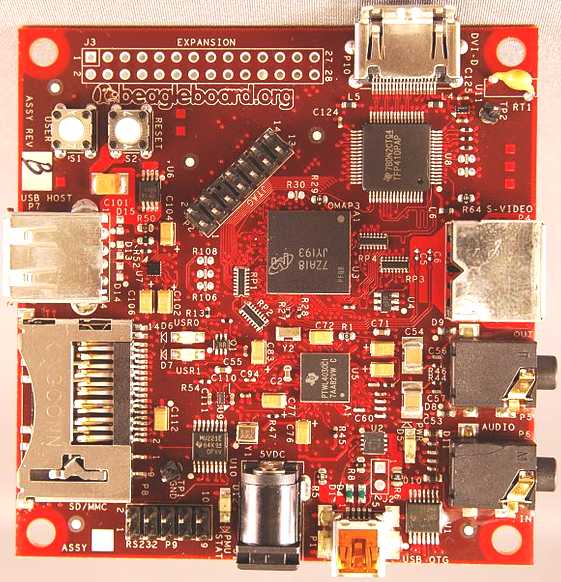
The Beagleboard
micro computer
BEAGLEBOARD COMPUTER
The
boards are low-cost, fan-less single-board computers based on low-power Texas
Instruments processors featuring the ARM Cortex-A series core with all of the
expandability of today's desktop machines, but without the bulk, expense, or
noise. The BeagleBoard is a low-power open-source hardware single-board computer produced by Texas Instruments in association with Digi-Key and Newark element14. The BeagleBoard was also designed with open source software development in mind, and as a way of demonstrating the Texas Instrument's OMAP3530 system-on-a-chip. The board was developed by a small team of engineers as an educational board that could be used in colleges around the world to teach open source hardware and open source software capabilities. It is also sold to the public under the Creative Commons share-alike license. The BeagleBoard measures approximately 75 by 75 mm and has all the functionality of a basic computer. The OMAP3530 includes an ARM Cortex-A8 CPU (which can run Linux, FreeBSD, OpenBSD, RISC OS, or Symbian; Android is also being ported), a TMS320C64x+ DSP for accelerated video and audio decoding, and an Imagination Technologies PowerVR SGX530 GPU to provide accelerated 2D and 3D rendering that supports OpenGL ES 2.0. Video out is provided through separate S-Video and HDMI connections. A single SD/MMC card slot supporting SDIO, a USB On-The-Go port, an RS-232 serial connection, a JTAG connection, and two stereo 3.5 mm jacks for audio in/out are provided.
Built-in storage and memory are provided through a PoP chip that includes 256 MB of NAND flash memory and 256 MB of RAM (128 MB on earlier models).
The board uses up to 2 W of power and can be powered from the USB connector, or a separate 5 V power supply. Because of the low power consumption, no additional cooling or heat sinks are required.
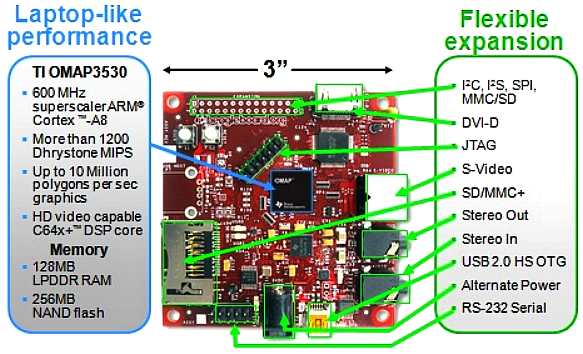
REV. C4 SPECIFICATIONS
Package on Package POP CPU/Memory chip.
Processor TI OMAP3530 Processor - 720 MHz ARM Cortex-A8 core
'HD capable' TMS320C64x+ core (520 MHz up to 720p @30 fps)
Imagination Technologies PowerVR SGX 2D/3D graphics processor supporting dual independent displays
256 MB LPDDR RAM
256 MB NAND Flash memory
Peripheral connections
DVI-D (HDMI connector chosen for size - maximum resolution is 1280×1024)
S-Video
USB OTG (mini AB)
1 USB port
SD/MMC card slot
Stereo in and out jacks
RS-232 port
JTAG connector
Power socket (5 V barrel connector type)
Development
Boot code stored in ROM
Boot from NAND memory, SD/MMC, USB, or serial
Alternative boot source button.
Has been demonstrated using Android, Angstrom Linux, Fedora, Ubuntu, Gentoo, Arch Linux ARM and Maemo Linux distributions, FreeBSD, the Windows CE operating system, Symbian, QNX and a version of RISC OS 5 made available by RISC OS Open. 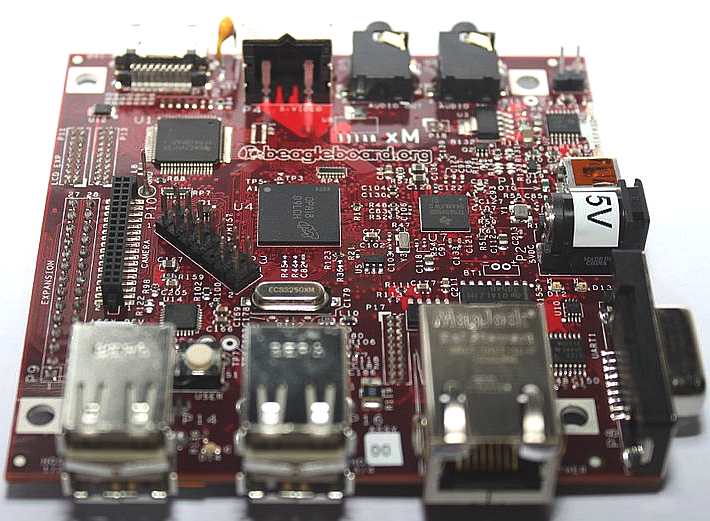
BEAGLEBOARD xM
A modified version of the BeagleBoard called the BeagleBoard-xM started shipping on August 27, 2010. The BeagleBoard-xM measures in at 82.55 by 82.55 mm and has a faster CPU core (clocked at 1 GHz compared to the 720 MHz of the BeagleBoard), more RAM (512 MB compared to 256 MB), onboard Ethernet jack, and 4 port USB hub. The BeagleBoard-xM lacks the onboard NAND and therefore requires the OS and other data to be stored on a microSD card. The addition of the Camera port to the -xM provides a simple way of importing video via Leopard Board cameras.
xM SPECIFICATIONS
Package on Package POP CPU/memory chip.
Processor TI DM3730 Processor - 1 GHz ARM Cortex-A8 core
'HD capable' TMS320C64x+ core (800 MHz up to 720p @30 fps)
Imagination Technologies PowerVR SGX 2D/3D graphics processor supporting dual independent displays
512 MB LPDDR RAM
4 GB microSD card supplied with the BeagleBoard-xM and loaded with The Angstrom Distribution
Peripheral connections
DVI-D (HDMI connector chosen for size - maximum resolution is 1400x1050)
S-Video
USB OTG (mini AB)
4 USB ports
Ethernet port
MicroSD/MMC card slot
Stereo in and out jacks
RS-232 port
JTAG connector
Power socket (5 V barrel connector type)
Camera port
Expansion port
Development
Boot code stored on the uSD card
Boot from uSD/MMC only
Alternative Boot source button.
Has been demonstrated using Android, Angstrom Linux, Fedora, Ubuntu, Gentoo, Arch Linux ARM and Maemo Linux distributions, FreeBSD, the Windows CE operating system, and RISC OS. BEAGLEBONE
DESCRIPTION
The BeagleBone Black compact ARM board has a TI Sitara 1 GHz Cortex-A8 processor with 512 MB of RAM and 2 GB eMMC flash storage (with a microSD card slot for additional storage). It comes preloaded with the Angstrom Linux and can run Ubuntu and Android . Initial setup is as easy as plugging the BeagleBone Black into the USB port of a computer, where it is recognized as a flash drive, and an HTML tutorial can be accessed.
The board can be powered with the included USB cable or a 5V Power Supply. It has a 10/100 ethernet port and microHDMI port for video and audio. The 2 x 46 pin Expansion Connectors provide GPIO, SPI, I2C, Analog In, Serial ports, CAN, PWM and can be used with Capes to add functionality. To house your BeagleBone Black, consider our BeagleBone Black Case, available in Black and Orange.
The BeagleBone's active development community makes it an ideal starting point for engineering projects, and the open-source nature of the hardware enables easy development.
Announced in the end of October 2011, the BeagleBone is a barebone development board with a Sitara ARM Cortex-A8 processor running at 720 MHz, 256 MB of RAM, two 46-pin expansion connectors, on-chip Ethernet, a microSD slot, and a USB host port and multipurpose device port which includes low-level serial control and JTAG hardware debug connections, so no JTAG emulator is required. The BeagleBone is initially priced $89(US).
A number of BeagleBone "Capes" have recently been released. These capes are expansion boards which can be stacked onto the BeagleBone Board (up to four at one time). BeagleBone capes include but are not limited to:
LCD touchscreen capes (7" and 3.5")
DVI-D cape
Breakout cape
Breadboard cape
CAN bus cape
RS-232 cape
Battery cape BEAGLEBONE
BLACK
Launched in April 23, 2013 at a price of $45. Among other differences, it increases RAM to 512 MB, the processor clock to 1 GHz, and it adds HDMI and 2 GB of eMMC flash memory. The BeagleBone Black also ships with Linux Kernel 3.8, upgraded from the original BeagleBone's Linux Kernel 3.2, allowing the BeagleBone Black to take advantage of Direct Rendering Manager
(DRM). OPTIONAL EXPANSION BOARDS * BeagleBoard Zippy - Feature expander daughter card for BeagleBoard
* BeagleBoard Zippy2 - Second-generation Zippy. (UART, EEPROM, 100BASE-T, SD-Slot, RTC, I²C (5 V))
* BeagleTouch Display - Touchscreen 4.3" OLED panel with touchscreen, and drivers for Angstrom Linux built by Liquidware.
* BeagleLCD2 Expansion Board - 4.3" wide aspect LCD panel + touchscreen with interface board. Developed by HY Research.
* BeagleJuice - Lithium-ion battery pack for portability developed and built by Liquidware.
* WLAN adapter - This additional expansion card enables wireless connectivity functionality for the BeagleBoard.
* BeadaFrame - 7" TFT LCD display kit includes touch panel and a plastic frame, by NAXING Electronics.
* 4DLCD CAPE - 4.3", 480x272 resolution LCD cape with resistive touch or non-touch and seven push buttons 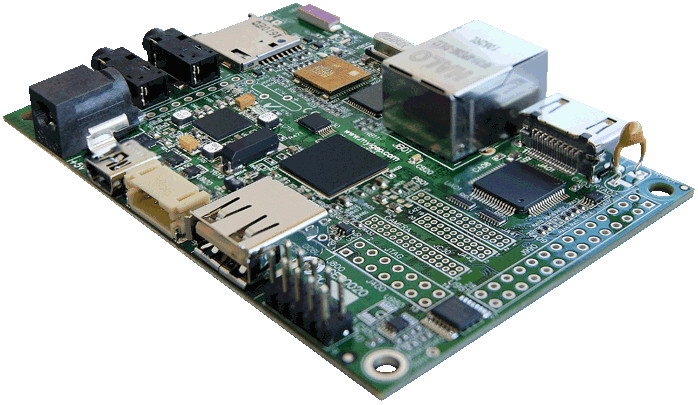
CLONES
- IGEPv2 The
IGEPv2 board is a
low-power, fanless single-board
computer based on the OMAP
3 series (also known as Cortex-A8)
of ARM-compatible
processors. It is developed and produced by Spanish corporation ISEE
and is the second IGEP platform in the series. The IGEPv2 is open hardware,
licensed under a Creative Commons Attribution-Non Commercial-ShareAlike 3.0
unported license.
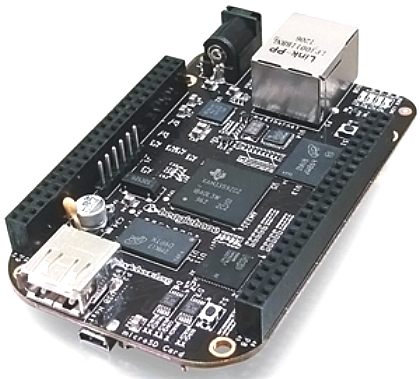
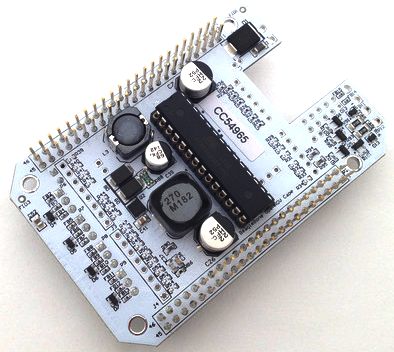
TI
TEXAS INSTRUMENTS HISTORY - MICROPROCESSOR INVENTION
Texas Instruments Inc. (TI) is an American company that designs and makes semiconductors, which it sells to electronics designers and manufacturers globally. Headquartered at Dallas, Texas, United States, TI is the third largest manufacturer of semiconductors worldwide after Intel and Samsung, the second largest supplier of chips for cellular handsets after Qualcomm, and the largest producer of digital signal processors (DSPs) and analog semiconductors, among a wide range of other semiconductor products, including calculators, microcontrollers and multi-core processors. Texas Instruments is among the Top 20 Semiconductor producing companies in the world.
Texas Instruments invented the hand-held calculator (a prototype called "Cal Tech") in 1967 and the single-chip microcomputer in 1971, and was assigned the first patent on a single-chip microprocessor (invented by Gary Boone) on September 4, 1973. This was disputed by Gilbert Hyatt, formerly of the Micro Computer Company, in August 1990 when he was awarded a patent superseding TI's. This was over-turned on June 19, 1996 in favor of TI. (Note: Intel is usually given credit with Texas Instruments for the almost-simultaneous invention of the microprocessor.)
|
Beaglebone
black SPECIFICATIONS
|
|
.
|
|
Processor/Chipset
|
Sitara
AM3359AZCZ100 1 GHz Cortex-A8
|
|
System
Memory
|
512MB
x DDR3L 400 SDRAM
|
|
Graphics
|
PowerVR
SGX530
|
|
Expansion
Slots
|
2
46-pin interfaces for capes
|
|
Storage
|
2
GB eMMC flash
MicroSD card slot
|
|
I/O
|
1
USB port
1 miniUSB port
1 microHDMI port
1 5V DC jack
|
|
Onboard
I/O Connectors
|
Debug
serial header
2 46-pin expansion connectors
Power button
Reset button
Boot switch
|
|
Software
|
Angstrom
(Linux-based, pre-installed)
Compatible with Linux, Android
|
|
Power
Input
|
210~460
mA @ 5 V
|
|
Dimensions
|
86.36
x 53.34 mm
3.4" x 2.1"
|
|
Recommended
Applications
|
HMI,
industrial workstations, All-in-ones
|
|
Support
|
See
BeagleBoard.org and the BeagleBone
Black Wiki
|
|
Includes
|
MiniUSB
to USB cable
|
|
Model
|
BeagleBone
Black
|
BeagleBone
|
BeagleBoard-xM
|
BeagleBoard
|
|
.
|
|
Target
price
|
US$
45
|
US$
89
|
US$
149
|
US$
125
|
|
Released
|
April
23, 2013
|
October
31, 2011
|
September
14, 2010
|
July
28, 2008
|
|
SoC
|
TI
AM3359
|
TI
AM3358/9
|
TI
DM3730
|
TI
OMAP3530
|
|
CPU
|
1 GHz
ARM
Cortex-A8
|
720 MHz
ARM
Cortex-A8
|
1 GHz
ARM
Cortex-A8
|
720 MHz
ARM
Cortex-A8
|
|
GPU
|
PowerVR
SGX530
|
PowerVR
SGX530
|
Unspecified
PowerVR
SGX,
TMS320C64x+
DSP
|
Unspecified
PowerVR
SGX
|
|
Memory
|
512 MB
DDR3
(2GB on-board flash version available)
|
256 MB
DDR2
|
512 MB
DDR2
|
256 KB
L2 cache
|
|
USB
2.0 ports:
|
|
|
|
|
|
Video
input
|
|
|
|
|
|
Video
outputs
|
microHDMI,
cape
add-ons
|
cape
add-ons
|
DVI-D,
S-Video
|
DVI-D,
S-Video
|
|
Audio
outputs
|
microHDMI,
cape
add-ons
|
cape
add-ons
|
3.5 mm
stereo jack
|
3.5 mm
stereo jack
|
|
Onboard
storage
|
|
|
|
|
|
Onboard
network
|
|
|
|
|
|
Low-level
peripherals
|
4x
UART, 8x PWM,
LCD,
GPMC, MMC1, 2x SPI, 2x I2C, A/D Converter, 2xCAN Bus, 4 Timers
|
4x
UART, 8x PWM,
LCD,
GPMC, MMC1, 2x SPI, 2x I2C, A/D Converter, 2xCAN Bus, 4 Timers, FTDI
USB to Serial, JTAG via USB
|
McBSP,
DSS,
I2C,
UART, LCD, McSPI, PWM, JTAG, Camera Interface
|
McBSP,
DSS,
I2C,
UART, McSPI, PWM, JTAG
|
|
Power
ratings
|
|
|
|
|
|
Power
source
|
|
|
|
|
|
Size
|
86.40 mm
× 53.3 mm (3.402 in × 2.10 in)
|
|
|
|
|
Weight
|
39.68 g
(1.400 oz)
|
|
|
|
|
Operating
systems
|
Out-of-the-box
in distributions like Fedora Core. Android (code named rowboat),
Ubuntu, openSUSE and Ångström. The board also supports other
OSes such as FreeBSD, QNX, and Windows Embedded.
|
|
|
|
BEAGLEBOARD
FOUNDATION
The
BeagleBoard.org Foundation is a US-based 501(c) non-profit corporation existing
to provide education in and promotion of the design and use of open-source
software and hardware in embedded computing.
BeagleBoard.org
provides a forum for the owners and developers of open-source software and
hardware to exchange ideas, knowledge and experience. On occasion,
BeagleBoard.org provides for the promotion of communication with other
individuals interested in open-source software and hardware.
BeagleBoard.org
is the result of an effort by a collection of passionate individuals, including
several employees of Texas Instruments, interested in creating powerful, open,
and embedded devices.
Support
for BeagleBoard.org boards comes from the very active development community
through their website, the mailing list, and the IRC channel. Original
production funding was provided by Digi-Key, a
major international distributor, but distribution has now been opened up to
dozens of distributors across the world.
On-going
funding for board prototypes has been provided by CircuitCo, manufacturer of the
boards. Texas Instruments generously allows Gerald Coley, hardware designer of
all of the BeagleBoard.org boards, and Jason Kridner, community manager and
software cat herder, to spend time to provide support and development of the
BeagleBoard.org project as part of their duties at TI.
CircuitCo
pays volume prices for the TI (and all other) components. BeagleBoard.org does
not currently get any money on board sales.
CircuitCo
Printed Circuit Board Solutions out of Richardson, TX is the primary
manufacturer of BeagleBoard.org products, but all the designs are fully open
source and components are available for anyone to manufacture compatible
hardware. It would be good form to let BeagleBoard.org know of intention to
produce compatible products.
With
tremendous success and support by numerous Linux distributions, development has
become more focused on enabling simplified physical computing on advanced
GUI-enabled and/or networked-enabled devices with a super-simple out-of-box
learning experience and support for development environments familiar to just
about every developer, from Ubuntu, QNX, Windows Embedded, Android and web tools
to bare metal and even Arduino/Wiring-style programming.
MEDIA
CONTACTS
Jason
Kridner
BeagleBoard.org co-founder
Telephone: 713-234-0535
Email: jkridner@beagleboard.org
Tara
Stratton
Media Relations
Telephone: 972-341-2562
Email: tstratton@golinharris.com
BEAGLEBOARD
FOUNDATION BOARD MEMBERS 2013
-
Gerald
Coley - Texas Instruments - Hardware design and QA
-
Clint
Cooley - CircuitCo - Sourcing and manufacturing
-
Jason
Kridner - Texas Instruments - Community manager and usability
Videos
ARDUINO
- ARM
HOLDINGS - BEAGLEBOARD
- MBED
- PICAXE
- RASPBERRY
PI
LINKS
http://beagleboard.org/project/AUV/
http://beagleboard.org/project/openrov/
http://beagleboard.org/project/Motion+Control/
http://beagleboard.org
http://beagleboard.org/Products/BeagleBone%20Black
http://www.logicsupply.com/products/bb_bblk_000
http://www.logicsupply.com/categories/motherboards/arm
http://www.gotransat.com/tracking/
http://www.picaxe.com/What-is-PICAXE/
http://3drobotics.com/
http://wiring.org.co/
http://www.arduino.cc/
http://www.designboom.com/technology/arduino-factory-tour/
http://www.raspberrypi.org/
http://www.python.org/
http://www.youtube.com/user/RaspberryPiTutorials
http://fishpi.org/contact.html
http://fishpi.org/forum/
http://rockblock.rock7mobile.com/
http://www.oceanbusiness.com/
https://code.google.com/p/raspy-juice/
http://www.yellowbrick-tracking.com/
http://fishpi.org/wiki/index.php?title=The_Proof-Of-Concept_Vehicle
http://fishpi.org/wiki/index.php?title=The_Prototype
http://fishpi.org/wiki/index.php?title=Hull_Design
http://www.modelsbydesign.co.uk/
http://www.raspberrypi.org/
http://international.findmespot.com/
http://www.amsat.org/
http://en.wikipedia.org/wiki/Composite_material#Autoclave_moulding
http://www.enecomitalia.com/ENG/caravans.html
Arduino
http://en.wikipedia.org/wiki/RobotC
|




